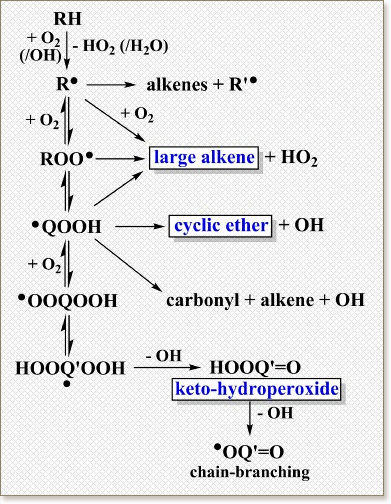Additional chain-branching pathways in the low-temperature oxidation of branched alkanes


Chain-branching reactions represent a general motif in chemistry, encountered in atmospheric chemistry, combustion, polymerization, and photochemistry; the nature and amount of radicals generated by chain-branching are decisive for the reaction progress, its energy signature, and the time towards its completion. In this study, experimental evidence for two new types of chain-branching reactions is presented, based upon detection of highly oxidized multifunctional molecules (HOM) formed during the gas-phase low-temperature oxidation of a branched alkane under conditions relevant to combustion. The oxidation of 2,5-dimethylhexane (DMH) in a jet-stirred reactor (JSR) was studied using synchrotron vacuum ultra-violet photoionization molecular beam mass spectrometry (SVUV-PI-MBMS). Specifically, species with four and five oxygen atoms were probed, having molecular formulas of C8H14O4 (e.g., diketo-hydroperoxide/keto-hydroperoxy cyclic ether) and C8H16O5 (e.g., keto-dihydroperoxide/dihydroperoxy cyclic ether), respectively. The formation of C8H16O5 species involves alternative isomerization of OOQOOH radicals via intramolecular H-atom migration, followed by third O2 addition, intramolecular isomerization, and OH release; C8H14O4 species are proposed to result from subsequent reactions of C8H16O5 species. The mechanistic pathways involving these species are related to those proposed as a source of low-volatility highly oxygenated species in Earth's troposphere. At the higher temperatures relevant to auto-ignition, they can result in a net increase of hydroxyl radical production, so these are additional radical chain-branching pathways for ignition. The results presented herein extend the conceptual basis of reaction mechanisms used to predict the reaction behavior of ignition, and have implications on atmospheric gas-phase chemistry and the oxidative stability of organic substances.

"KAUST shall be a beacon for peace, hope and reconciliation, and shall serve the people of the Kingdom and the world."
King Abdullah bin Abdulaziz Al Saud, 1924 – 2015
Thuwal 23955-6900, Kingdom of Saudi Arabia
© King Abdullah University of Science and Technology. All rights reserved